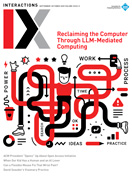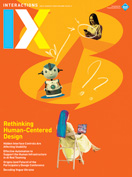Authors:
Jonathan Bean
In 2017, when the editors of Interactions suggested we rename this column "Consuming Tech," the change appealed to me, because it reflected a focus on the effects of the humans involved in human-computer interaction. Making consumer devices requires material resources and energy. It takes rare earths to manufacture smartphones and antennas, not to mention the power and communications grids underpinning our networked world. And then there is the energy needed to run the server farms and services that make devices work, or, to ape the abstracted language of the market, that provide value to consumers.
In light of AI's unrelenting and voracious appetite for energy, the concerns expressed in the column I wrote back in 2016 on the energy impact of high-resolution display technologies seem quaint [1]. At that time, the amount of energy used by TVs and monitors varied broadly enough that some models could cost consumers $19 more a year to run than the most efficient options. I proposed baking this difference into the upfront cost of the appliance, thereby transforming the kind of future cost that we know from consumer psychology is likely to be irrationally discounted into a present cost that might have concrete impacts on shifting behavior.
In the U.S., we've recently been hearing a steady drumbeat of calls to provide consumers more choices and increase the affordability of everything from housing to appliances. While making things cheaper to buy upfront sounds like a commonsense formula for increasing access and placating inflation-weary voters, most people know from experience that a myopic focus on making things cheap in the short term usually costs more in the long term. Those bargain tires for the car? They wear out faster and might not let you stop in time to avoid an accident. That cheap plumber? Have fun bailing out your basement on a holiday weekend.
Affordability also implies a time horizon. It's one thing for a $130 pair of wireless earbuds to become waste after a few years. But what about an entire $2,000 electric range? While there's no shortage of examples that appeal to both common sense and experience, there is evidence that consumers simply don't expect the things they buy to last very long. One expert quoted by The New York Times' Wirecutter, a product recommendation site, suggested consumers "start thinking of these expensive appliances as being more like their cars, phones, or any other complicated, tech-loaded, feature-rich product encased in a sleek design that they put through hard use every single day" [2]. If you buy something expecting it to break, it is entirely rational to want the thing to be as cheap as possible, provided it lasts longer than it takes for the shine to wear off. The same article laid the blame for the drop-off in durability on the growing reliance of manufacturers to include electronic control boards in otherwise simple appliances.
Tending the garden of things that supposedly make life easier can unleash more demands on our time.
In part, the Wirecutter article blames the inclusion of unreliable and difficult-to-repair electronic control boards on the increasingly stringent government efficiency requirements, but it seems that the inclusion of computing capacity in otherwise simple appliances is often the answer to consumers' insatiable demand for innovation. After all, you never have to worry about whether you've turned off a WiFi range. Of course, that assumes you've kept on top of keeping it connected to your network and updating the proprietary app on your phone. Despite being a late joiner of the smart home party, I've already worked my way through three separate, non-cross-compatible apps to control networked light bulbs. The experience of moving each bulb from one proprietary app to another gave me a real appreciation for the simple reliability of the programmable, non-Internet-connected timer switch that brings light to my front porch every evening. In between writing this column and responding to editor queries, however, that very switch ceased to function, so it will be replaced with an Internet-connected model. As historian Ruth Schwartz Cowan observed in her 1983 book, More Work for Mother: The Ironies of Household Technology from the Open Hearth to the Microwave, tending the garden of things that supposedly make life easier can unleash more demands on our time.
When I look at how technology is framed in the mass media, and it's almost always AI these days, I'm thinking less of the material, energetic, and environmental impacts of our collective technology use and more about the ways in which AI technology is consuming human work. Simone D.J. Barbosa, the former Interactions editor who suggested the column name way back in the horse-and-buggy era of 2017, wrote in an email that Consuming Tech "could be viewed as us consuming it or it consuming us." Indeed, descriptions of how AI models are trained often use the words ingest and eat: AI ate my book. The new AI model ingested 50,000 articles about molecular structure. Whether metaphor or analogy, the words seem apt for the unending hunger of the AI monster. They are also fuel for AI skeptics who see a degradation in quality as an inescapable consequence of the process. To the established vocabulary of slop and hallucinations, this metaphor suggests the possibility of a rigorous naming system for a bevy of metabolic and digestive processes for the inevitable outputs of all that input.
Scatological humor aside, AI's appetite is a telling metaphor, because it suggests an inversion of the relationship that existed between humans and technology before AI came along. The hopes and dreams for AI (e.g., providing three-hour workdays for all; finding a universal cure for cancer; unlocking the key to fusion energy) are dependent on us accepting our new role as AI's subservient feeder, caretaker, and enabler. The technology no longer works for us. Instead, we work for it, cultivating the text and image content it eats to inform its algorithms, reforming Earth's landscape to provide space for data centers, and shouldering the bill for its vast intake of electricity.
One possible ending to this story: Imagine throwing a dinner party and discovering the next day your guests had picked the cupboards bare. Another, darker possibility: realizing that we're the ones on the menu. While I am not one to promulgate theories of Matrix-style simulations, one way to think about how we are feeding AI is to fall back hard on a diet metaphor. Are we providing nutritious and nourishing meals, with the variety it takes to grow something healthy? Or are we feeding the beast with the equivalent of junk food, protein powder, and energy drinks? The meal we put on the table will shape not only the form AI takes but also the norms of the society that will exist with and alongside our new, and very hungry, overlords.
1. Bean, J. On high-def Diderot and the cost of climate change. Interactions 24, 1 (2016), 22–23; http://bit.ly/3Kc4MKM
2. Wharton, R. The real reasons your appliances die young. Wirecutter, The New York Times, Jun. 24, 2025; http://bit.ly/3K4dZ7Q
Jonathan Bean is director of the Institute for Energy Solutions and an associate professor at the University of Arizona. He studies taste, technology, and market transformation. [email protected]
Copyright 2025 held by owner/author
The Digital Library is published by the Association for Computing Machinery. Copyright © 2025 ACM, Inc.









Post Comment
No Comments Found